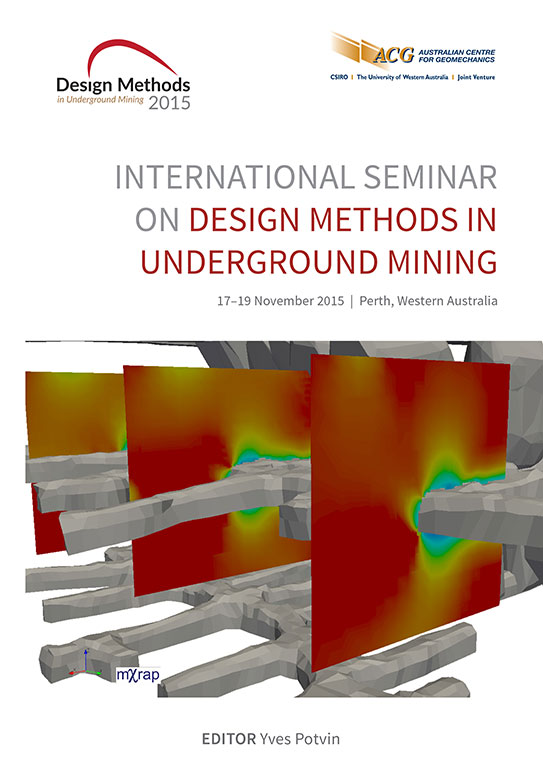Design and management processes involved with extracting regional pillar stopes in a seismic setting at Darlot Gold Mine

|
Authors: Moulding, C; Andrews, P |
DOI https://doi.org/10.36487/ACG_rep/1511_05_Moulding
Cite As:
Moulding, C & Andrews, P 2015, 'Design and management processes involved with extracting regional pillar stopes in a seismic setting at Darlot Gold Mine', in Y Potvin (ed.), Design Methods 2015: Proceedings of the International Seminar on Design Methods in Underground Mining, Australian Centre for Geomechanics, Perth, pp. 135-148, https://doi.org/10.36487/ACG_rep/1511_05_Moulding
Abstract:
This paper outlines the protocols introduced for the management of potential seismic risk, including monitoring, numerical modelling, extraction sequencing and the necessary support upgrades to mitigate the risks at Darlot Gold Mine. The Walters Lode is located 400 m below surface and uses a longhole mining method retreating back to a regional pillar. The lode is hosted within a strong dolerite host rock (uniaxial compressive strength (UCS) = 220 MPa+), with a UCS that often exceeds 200 MPa, with the main mineralised lode following along a structure called the first slip fault. This structure pinches and swells at varying depths and is usually identified by quartz intrusions and a 0.5-1.0 m sheared zoned along the plane. This fault dips at approximately 50° to the west. In addition to the first slip fault, there are multiple intersecting faults throughout the area. Originally the ground support for the development drives was not designed for seismic conditions and predominantly utilised resin bolts installed over fibrecrete. As the mining front began to retreat towards the pillar, mining induced stresses began acting upon the rock mass and the structures in the area. The rock mass response to these changes included an increase in seismic activity and deformation. This increased activity led to a review of the seismic management risk procedures at Darlot. Initial changes included upgrading the ground support regime to a yielding system capable of retaining the rock mass in response to predicted levels of seismicity. Expected levels of seismicity were obtained by undertaking a review of historical seismic data in the area. Non-linear elastic modelling was also undertaken to determine the potential seismic response and predicted damage to the rock mass based on the proposed extraction sequence. Based on these results, a geotechnically optimised stoping sequence was proposed. Internal numerical modelling has been conducted to account for newly found stope shapes relative to the original extraction sequence. The results that show potential depths of failure are used to strategically plan and account for additional overbreak or brow damage in the mining plan. Ongoing seismic monitoring and analysis is used to determine seismic exclusion zones and re-entry times. All of the above changes are used to continually calibrate the existing models, and ongoing data collection has resulted in an optimal extraction sequence, therefore allowing a safe and productive extraction of the Walters Lode.
References:
Barton, N, Lien, R & Lunde, J 1974, ‘Engineering classification of rock masses for design of tunnel support’, Rock Mechanics and Rock Engineering, vol. 6, no. 4, pp. 189-236.
Beck Engineering Pty Ltd 2012, Calibration and forward analysis of Boon North – middle Walters stress window area’, report, Beck Engineering Pty Ltd, Chatswood West.
Gutenberg, R & Richter, CF 1944, ‘Frequency of earthquakes in California’, Bulletin of the Seismological Society of America, vol. 34, pp. 185-188.
JORC 2012, Joint Ore Reserves Committee, JORC Code: Australasian Code for Reporting of Exploration Results, Mineral Resources and Ore Reserves, Joint Ore Reserves Committee, South Carlton, pp. 18-19,
Kaiser, PK, McCreath, DR & Tannant, DD 1996, Canadian rockburst support handbook, Geomechanics Research Centre, Sudbury.
Mitchell, RJ & Roettger, JJ 1989, ‘Analysis and modelling of sill pillars’, in FP Hassani, MJ Scoble & TR Yu (eds), Proceedings of the Fourth International Symposium on Mining with Backfill, Innovations in Mining Backfill Technology, Balkema, Rotterdam,
pp. 53-62.
© Copyright 2025, Australian Centre for Geomechanics (ACG), The University of Western Australia. All rights reserved.
View copyright/legal information
Please direct any queries or error reports to repository-acg@uwa.edu.au
View copyright/legal information
Please direct any queries or error reports to repository-acg@uwa.edu.au